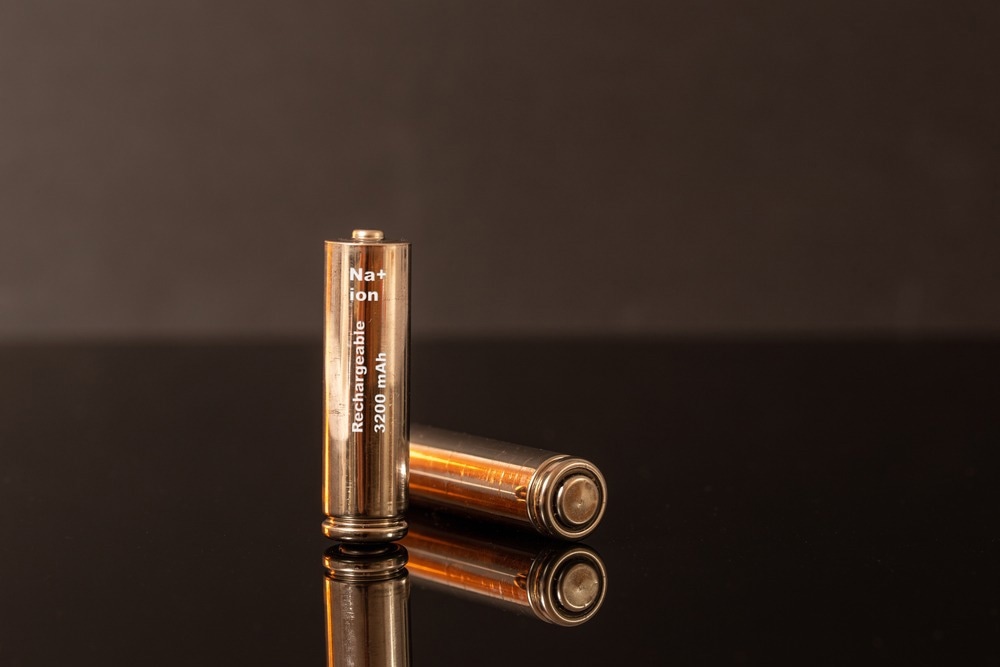A team of researchers recently published a paper in the journal ACS Applied Energy Materials that demonstrated the effectiveness of using Prussian white (PW) aggregates to prepare cathodes for high-temperature sodium-ion batteries (SIBs).

Study: Polycrystalline Prussian White Aggregates as a High-Rate and Long-Life Cathode for High-Temperature Sodium-Ion Batteries. Image Credit: gcarnero/Shutterstock.com
Background
Cost-effective and advanced energy storage systems with stable cycling over a large temperature range from -25 oC to 70 oC and high power and energy density have gained significant prominence due to the increasing demand for grid-scale electric energy storage and electric vehicles. SIBs have received considerable attention as a potential electrochemical energy storage system as they are low-cost and naturally abundant.
PW (Na2Fe[Fe(CN)6]) cathode materials have demonstrated a high theoretical capacity of 170 mAh g−1, improved high rate performance at room temperatures, and negligible variations in volume upon cycling. The abundant and large interstitial sodium (Na+) ion storage sites in PW can effectively reduce the stress/strain caused by the Na+ deintercalation/intercalation process, resulting in a stable host structure even after extensive cycling.
Moreover, the three-dimensional (3D) ion transport pathways, weak interaction between Na+ and the host structure, and open and rigid frameworks ensure fast ion transfer kinetics at subzero temperatures. For instance, a composite cathode material synthesized by nucleating PW cubic particles on a carbon nanotube demonstrated exceptional performance in terms of high power and specific energy densities at -25 oC.
However, the PW cathode material capacity often decreases at a rapid rate at high temperatures due to the vigorous side reactions occurring at the interphases and bulk structure. For instance, a PW cathode operated at 55 oC and room temperature demonstrated the capacity retentions of 54.7% and 73.4%, respectively, after 200 cycles. Thus, the poor cycle stability of PW at high temperatures remains a significant challenge.
The Study
In this study, researchers synthesized a PW cathode material and investigated its fast and stable Na+ ion storage performance at temperatures up to 70 oC.
Poly-PW was synthesized using the precipitation method. Initially, sodium ferrocyanide (Na4Fe(CN)6.H2O) was dissolved in deionized (DI) water to obtain solution A, while trisodium citrate and ferrous sulfate (FeSO4·7H2O) were dissolved in DI water to prepare solution B.
Solution A was then added to solution B at a three mL/min rate under 1200 rpm/min magnetic stirring. After aging the mixture for 24 h, the resultant white precipitates were collected by centrifugation, washed with anhydrous ethanol and DI water, and dried overnight using a vacuum oven at 120 oC.
70 wt % active material/PW, 10 wt% poly(vinylidene fluoride), and 20 wt % acetylene black were added to N-methyl-2-pyrrolidone to obtain a homogeneous slurry, which was then coated on an aluminum foil. The slurry-coated foil was dried overnight at 120 oC, and then cut into 12 mm diameter disks to obtain the working electrode with three mg cm−2 average active material/PW loading.
The electrochemical test was conducted using CR2025 coin cells in which one M sodium perchlorate (NaClO4) in propylene carbonate (PC)/ethylene carbonate (EC) with five vol % fluoroethylene carbonate (FEC) was utilized as an electrolyte and Na metal disks were employed as the counter electrode. Porous glass fiber was used as a separator. An argon-filled glovebox with less than one ppm oxygen and moisture levels was employed to assemble the cells.
Thermogravimetric analysis, atomic absorption spectroscopy (AAS), X-ray diffraction (XRD) method, field-emission scanning electron microscopy (FESEM), and energy-dispersive X-ray spectroscopy (EDS) were used for the electrochemical characterization and measurements.
The electrochemical performance of the cells was evaluated using a LAND CT2001A battery tester within a 2.0 −4.2 V voltage range under different current densities at several temperatures. Researchers also performed cyclic voltammetry (CV) and electrochemical impedance spectroscopy (EIS).
Observations
A polycrystalline poly-PW aggregate cathode material was synthesized successfully using the precipitation method. The stirring speed played a crucial role in the formation of secondary particles containing densely packed primary particles.
The small surface-to-volume ratio of the cathode decreased the side-reaction between the electrode and electrolyte solution, which improved the surface interface thermodynamic stability. The uneven and aggregated surfaces also ensured good electrical contact with the current collector and acetylene black even after extended cycles.
The unique morphology of the synthesized cathode significantly improved the low-spin iron (Fe) redox pair stability at higher temperatures, leading to a high rate capability and impressive cycling stability. The capacity retentions of the poly-PW cathodes cycled at 70 oC and 50 oC were 77.8% and 82.8%, respectively, over 300 cycles. Poly-PW displayed 99 mAh g−1 capacity at a high rate of 30C compared to 73% at 0.3C.
Conclusion
Taken together, the findings of this study provided an insight into the design of the PW material with enhanced high-temperature performance and demonstrated the feasibility of using PW aggregates as a long-life and high-rate cathode in high-temperature SIBs. Thus, a practical SIB with poly-PW cathode is expected to function safely and stably and demonstrate a high cycling performance in hot regions such as Africa during summer.
More from AZoM: Reviewing the Use of Computational NIR Spectroscopy
Disclaimer: The views expressed here are those of the author expressed in their private capacity and do not necessarily represent the views of AZoM.com Limited T/A AZoNetwork the owner and operator of this website. This disclaimer forms part of the Terms and conditions of use of this website.
Source:
You, Y., Yang, C., Huang, X. et al. Polycrystalline Prussian White Aggregates as a High-Rate and Long-Life Cathode for High-Temperature Sodium-Ion Batteries. ACS Applied Energy Materials 2022. https://pubs.acs.org/doi/10.1021/acsaem.2c00646